HRM Report: Analyzing Business Issues and HR at KazMunaygas
VerifiedAdded on 2020/06/05
|14
|4667
|453
Report
AI Summary
This report examines Human Resource Management (HRM) issues within the context of KazMunaygas, a major player in the oil and gas industry. It begins by identifying key factors impacting the organization, such as government regulations, economic conditions, technological advancements, and employee relations, and discusses their influence on HR functions. The report then explores the development of organizational and HR strategies, emphasizing the importance of aligning HR goals with overall business objectives. It delves into the forces shaping the HR agenda, including competition, market trends, and stakeholder satisfaction, highlighting the role of HR in supporting business performance and employee development. Furthermore, the report utilizes tools like SWOT and PEST analyses to assess the business environment, both internally and externally. It outlines the stages of strategy formulation, implementation, and evaluation, underscoring the contribution of HR at each stage. Finally, it addresses HR's role in business ethics, change management, and performance evaluation, including the use of tools like the balanced scorecard and the different sources of business and contextual data for planning processes. The report concludes with a comprehensive overview of the challenges and opportunities facing HRM in a dynamic business environment.
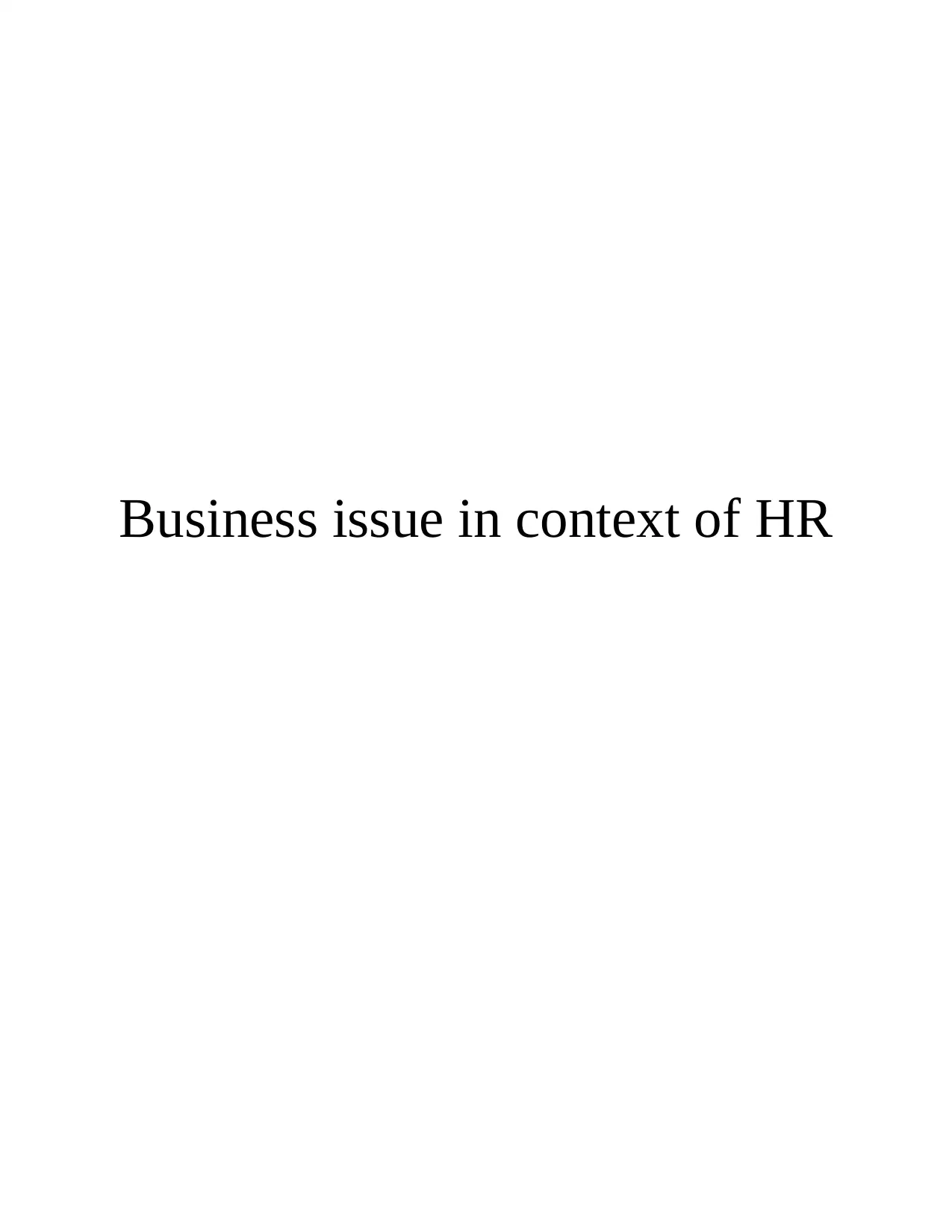
Business issue in context of HR
Paraphrase This Document
Need a fresh take? Get an instant paraphrase of this document with our AI Paraphraser
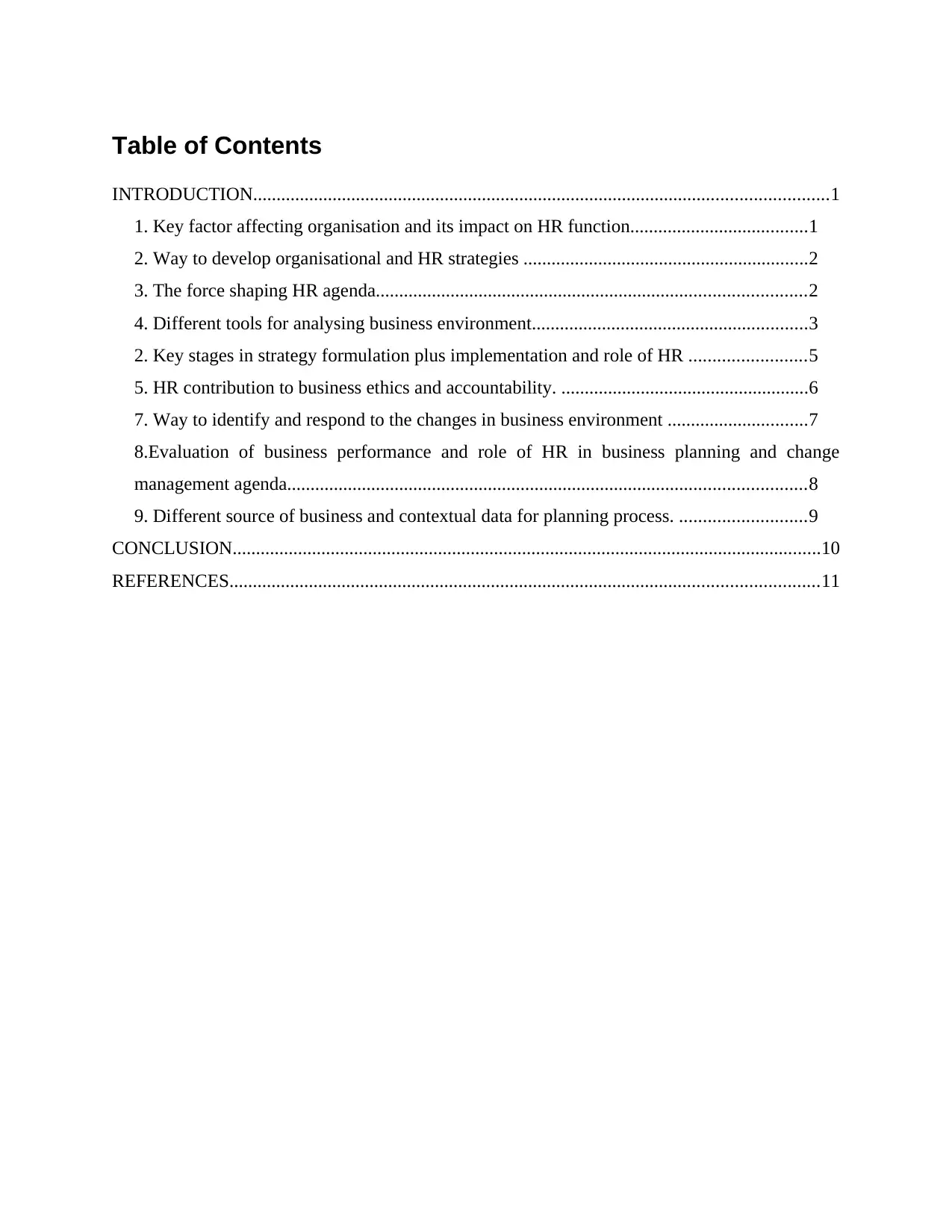
Table of Contents
INTRODUCTION...........................................................................................................................1
1. Key factor affecting organisation and its impact on HR function......................................1
2. Way to develop organisational and HR strategies .............................................................2
3. The force shaping HR agenda............................................................................................2
4. Different tools for analysing business environment...........................................................3
2. Key stages in strategy formulation plus implementation and role of HR .........................5
5. HR contribution to business ethics and accountability. .....................................................6
7. Way to identify and respond to the changes in business environment ..............................7
8.Evaluation of business performance and role of HR in business planning and change
management agenda...............................................................................................................8
9. Different source of business and contextual data for planning process. ...........................9
CONCLUSION..............................................................................................................................10
REFERENCES..............................................................................................................................11
INTRODUCTION...........................................................................................................................1
1. Key factor affecting organisation and its impact on HR function......................................1
2. Way to develop organisational and HR strategies .............................................................2
3. The force shaping HR agenda............................................................................................2
4. Different tools for analysing business environment...........................................................3
2. Key stages in strategy formulation plus implementation and role of HR .........................5
5. HR contribution to business ethics and accountability. .....................................................6
7. Way to identify and respond to the changes in business environment ..............................7
8.Evaluation of business performance and role of HR in business planning and change
management agenda...............................................................................................................8
9. Different source of business and contextual data for planning process. ...........................9
CONCLUSION..............................................................................................................................10
REFERENCES..............................................................................................................................11
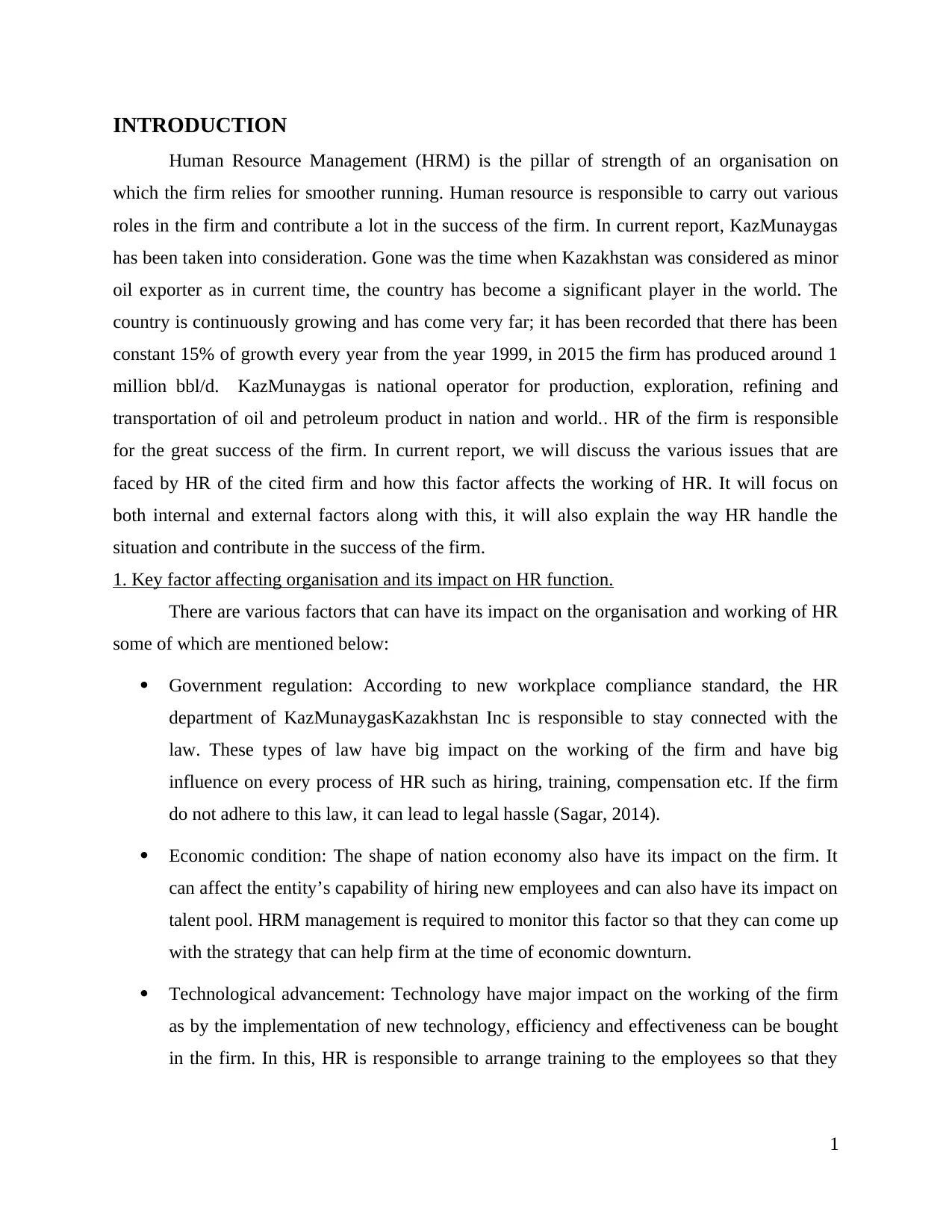
INTRODUCTION
Human Resource Management (HRM) is the pillar of strength of an organisation on
which the firm relies for smoother running. Human resource is responsible to carry out various
roles in the firm and contribute a lot in the success of the firm. In current report, KazMunaygas
has been taken into consideration. Gone was the time when Kazakhstan was considered as minor
oil exporter as in current time, the country has become a significant player in the world. The
country is continuously growing and has come very far; it has been recorded that there has been
constant 15% of growth every year from the year 1999, in 2015 the firm has produced around 1
million bbl/d. KazMunaygas is national operator for production, exploration, refining and
transportation of oil and petroleum product in nation and world.. HR of the firm is responsible
for the great success of the firm. In current report, we will discuss the various issues that are
faced by HR of the cited firm and how this factor affects the working of HR. It will focus on
both internal and external factors along with this, it will also explain the way HR handle the
situation and contribute in the success of the firm.
1. Key factor affecting organisation and its impact on HR function.
There are various factors that can have its impact on the organisation and working of HR
some of which are mentioned below:
Government regulation: According to new workplace compliance standard, the HR
department of KazMunaygasKazakhstan Inc is responsible to stay connected with the
law. These types of law have big impact on the working of the firm and have big
influence on every process of HR such as hiring, training, compensation etc. If the firm
do not adhere to this law, it can lead to legal hassle (Sagar, 2014).
Economic condition: The shape of nation economy also have its impact on the firm. It
can affect the entity’s capability of hiring new employees and can also have its impact on
talent pool. HRM management is required to monitor this factor so that they can come up
with the strategy that can help firm at the time of economic downturn.
Technological advancement: Technology have major impact on the working of the firm
as by the implementation of new technology, efficiency and effectiveness can be bought
in the firm. In this, HR is responsible to arrange training to the employees so that they
1
Human Resource Management (HRM) is the pillar of strength of an organisation on
which the firm relies for smoother running. Human resource is responsible to carry out various
roles in the firm and contribute a lot in the success of the firm. In current report, KazMunaygas
has been taken into consideration. Gone was the time when Kazakhstan was considered as minor
oil exporter as in current time, the country has become a significant player in the world. The
country is continuously growing and has come very far; it has been recorded that there has been
constant 15% of growth every year from the year 1999, in 2015 the firm has produced around 1
million bbl/d. KazMunaygas is national operator for production, exploration, refining and
transportation of oil and petroleum product in nation and world.. HR of the firm is responsible
for the great success of the firm. In current report, we will discuss the various issues that are
faced by HR of the cited firm and how this factor affects the working of HR. It will focus on
both internal and external factors along with this, it will also explain the way HR handle the
situation and contribute in the success of the firm.
1. Key factor affecting organisation and its impact on HR function.
There are various factors that can have its impact on the organisation and working of HR
some of which are mentioned below:
Government regulation: According to new workplace compliance standard, the HR
department of KazMunaygasKazakhstan Inc is responsible to stay connected with the
law. These types of law have big impact on the working of the firm and have big
influence on every process of HR such as hiring, training, compensation etc. If the firm
do not adhere to this law, it can lead to legal hassle (Sagar, 2014).
Economic condition: The shape of nation economy also have its impact on the firm. It
can affect the entity’s capability of hiring new employees and can also have its impact on
talent pool. HRM management is required to monitor this factor so that they can come up
with the strategy that can help firm at the time of economic downturn.
Technological advancement: Technology have major impact on the working of the firm
as by the implementation of new technology, efficiency and effectiveness can be bought
in the firm. In this, HR is responsible to arrange training to the employees so that they
1
⊘ This is a preview!⊘
Do you want full access?
Subscribe today to unlock all pages.

Trusted by 1+ million students worldwide
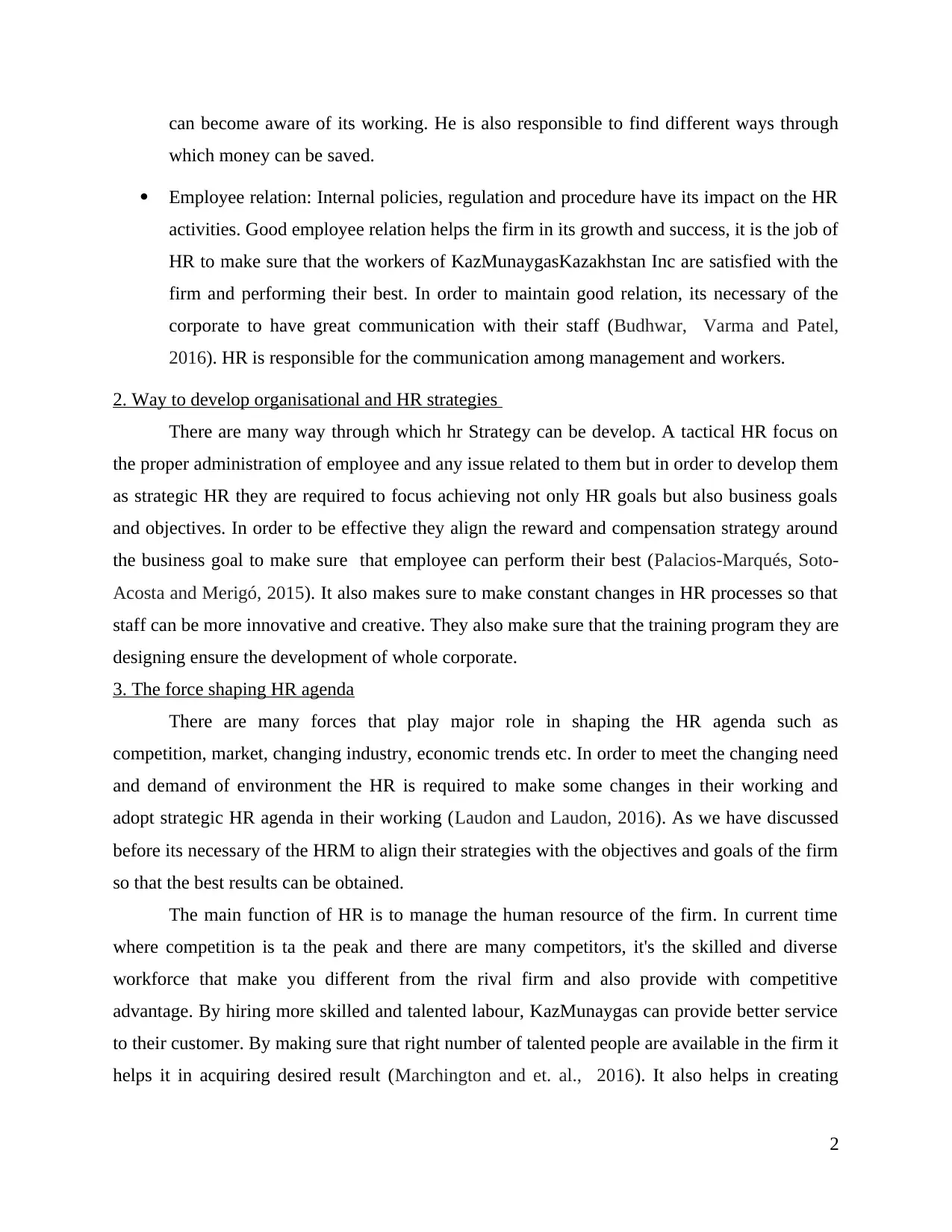
can become aware of its working. He is also responsible to find different ways through
which money can be saved.
Employee relation: Internal policies, regulation and procedure have its impact on the HR
activities. Good employee relation helps the firm in its growth and success, it is the job of
HR to make sure that the workers of KazMunaygasKazakhstan Inc are satisfied with the
firm and performing their best. In order to maintain good relation, its necessary of the
corporate to have great communication with their staff (Budhwar, Varma and Patel,
2016). HR is responsible for the communication among management and workers.
2. Way to develop organisational and HR strategies
There are many way through which hr Strategy can be develop. A tactical HR focus on
the proper administration of employee and any issue related to them but in order to develop them
as strategic HR they are required to focus achieving not only HR goals but also business goals
and objectives. In order to be effective they align the reward and compensation strategy around
the business goal to make sure that employee can perform their best (Palacios-Marqués, Soto-
Acosta and Merigó, 2015). It also makes sure to make constant changes in HR processes so that
staff can be more innovative and creative. They also make sure that the training program they are
designing ensure the development of whole corporate.
3. The force shaping HR agenda
There are many forces that play major role in shaping the HR agenda such as
competition, market, changing industry, economic trends etc. In order to meet the changing need
and demand of environment the HR is required to make some changes in their working and
adopt strategic HR agenda in their working (Laudon and Laudon, 2016). As we have discussed
before its necessary of the HRM to align their strategies with the objectives and goals of the firm
so that the best results can be obtained.
The main function of HR is to manage the human resource of the firm. In current time
where competition is ta the peak and there are many competitors, it's the skilled and diverse
workforce that make you different from the rival firm and also provide with competitive
advantage. By hiring more skilled and talented labour, KazMunaygas can provide better service
to their customer. By making sure that right number of talented people are available in the firm it
helps it in acquiring desired result (Marchington and et. al., 2016). It also helps in creating
2
which money can be saved.
Employee relation: Internal policies, regulation and procedure have its impact on the HR
activities. Good employee relation helps the firm in its growth and success, it is the job of
HR to make sure that the workers of KazMunaygasKazakhstan Inc are satisfied with the
firm and performing their best. In order to maintain good relation, its necessary of the
corporate to have great communication with their staff (Budhwar, Varma and Patel,
2016). HR is responsible for the communication among management and workers.
2. Way to develop organisational and HR strategies
There are many way through which hr Strategy can be develop. A tactical HR focus on
the proper administration of employee and any issue related to them but in order to develop them
as strategic HR they are required to focus achieving not only HR goals but also business goals
and objectives. In order to be effective they align the reward and compensation strategy around
the business goal to make sure that employee can perform their best (Palacios-Marqués, Soto-
Acosta and Merigó, 2015). It also makes sure to make constant changes in HR processes so that
staff can be more innovative and creative. They also make sure that the training program they are
designing ensure the development of whole corporate.
3. The force shaping HR agenda
There are many forces that play major role in shaping the HR agenda such as
competition, market, changing industry, economic trends etc. In order to meet the changing need
and demand of environment the HR is required to make some changes in their working and
adopt strategic HR agenda in their working (Laudon and Laudon, 2016). As we have discussed
before its necessary of the HRM to align their strategies with the objectives and goals of the firm
so that the best results can be obtained.
The main function of HR is to manage the human resource of the firm. In current time
where competition is ta the peak and there are many competitors, it's the skilled and diverse
workforce that make you different from the rival firm and also provide with competitive
advantage. By hiring more skilled and talented labour, KazMunaygas can provide better service
to their customer. By making sure that right number of talented people are available in the firm it
helps it in acquiring desired result (Marchington and et. al., 2016). It also helps in creating
2
Paraphrase This Document
Need a fresh take? Get an instant paraphrase of this document with our AI Paraphraser
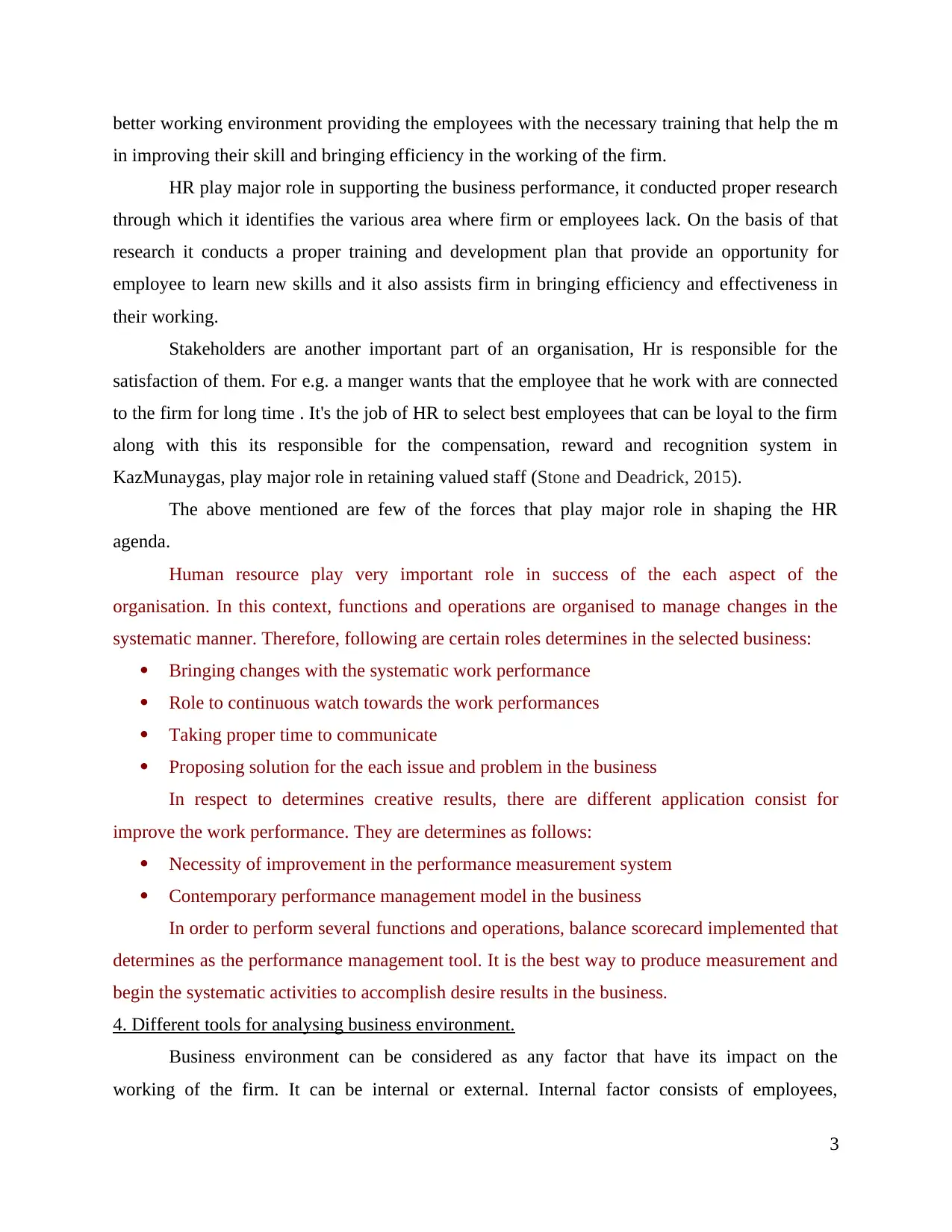
better working environment providing the employees with the necessary training that help the m
in improving their skill and bringing efficiency in the working of the firm.
HR play major role in supporting the business performance, it conducted proper research
through which it identifies the various area where firm or employees lack. On the basis of that
research it conducts a proper training and development plan that provide an opportunity for
employee to learn new skills and it also assists firm in bringing efficiency and effectiveness in
their working.
Stakeholders are another important part of an organisation, Hr is responsible for the
satisfaction of them. For e.g. a manger wants that the employee that he work with are connected
to the firm for long time . It's the job of HR to select best employees that can be loyal to the firm
along with this its responsible for the compensation, reward and recognition system in
KazMunaygas, play major role in retaining valued staff (Stone and Deadrick, 2015).
The above mentioned are few of the forces that play major role in shaping the HR
agenda.
Human resource play very important role in success of the each aspect of the
organisation. In this context, functions and operations are organised to manage changes in the
systematic manner. Therefore, following are certain roles determines in the selected business:
Bringing changes with the systematic work performance
Role to continuous watch towards the work performances
Taking proper time to communicate
Proposing solution for the each issue and problem in the business
In respect to determines creative results, there are different application consist for
improve the work performance. They are determines as follows:
Necessity of improvement in the performance measurement system
Contemporary performance management model in the business
In order to perform several functions and operations, balance scorecard implemented that
determines as the performance management tool. It is the best way to produce measurement and
begin the systematic activities to accomplish desire results in the business.
4. Different tools for analysing business environment.
Business environment can be considered as any factor that have its impact on the
working of the firm. It can be internal or external. Internal factor consists of employees,
3
in improving their skill and bringing efficiency in the working of the firm.
HR play major role in supporting the business performance, it conducted proper research
through which it identifies the various area where firm or employees lack. On the basis of that
research it conducts a proper training and development plan that provide an opportunity for
employee to learn new skills and it also assists firm in bringing efficiency and effectiveness in
their working.
Stakeholders are another important part of an organisation, Hr is responsible for the
satisfaction of them. For e.g. a manger wants that the employee that he work with are connected
to the firm for long time . It's the job of HR to select best employees that can be loyal to the firm
along with this its responsible for the compensation, reward and recognition system in
KazMunaygas, play major role in retaining valued staff (Stone and Deadrick, 2015).
The above mentioned are few of the forces that play major role in shaping the HR
agenda.
Human resource play very important role in success of the each aspect of the
organisation. In this context, functions and operations are organised to manage changes in the
systematic manner. Therefore, following are certain roles determines in the selected business:
Bringing changes with the systematic work performance
Role to continuous watch towards the work performances
Taking proper time to communicate
Proposing solution for the each issue and problem in the business
In respect to determines creative results, there are different application consist for
improve the work performance. They are determines as follows:
Necessity of improvement in the performance measurement system
Contemporary performance management model in the business
In order to perform several functions and operations, balance scorecard implemented that
determines as the performance management tool. It is the best way to produce measurement and
begin the systematic activities to accomplish desire results in the business.
4. Different tools for analysing business environment.
Business environment can be considered as any factor that have its impact on the
working of the firm. It can be internal or external. Internal factor consists of employees,
3
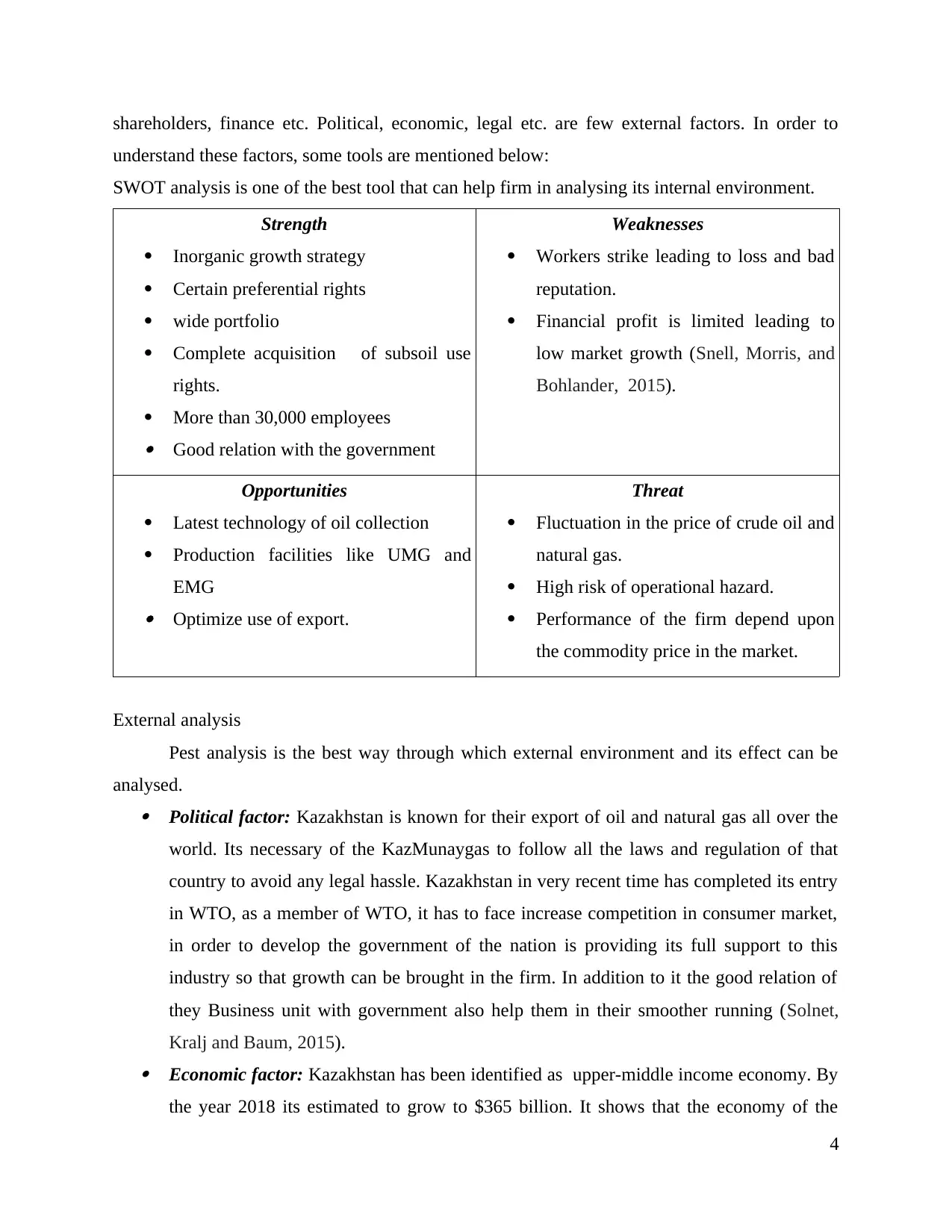
shareholders, finance etc. Political, economic, legal etc. are few external factors. In order to
understand these factors, some tools are mentioned below:
SWOT analysis is one of the best tool that can help firm in analysing its internal environment.
Strength
Inorganic growth strategy
Certain preferential rights
wide portfolio
Complete acquisition of subsoil use
rights.
More than 30,000 employees Good relation with the government
Weaknesses
Workers strike leading to loss and bad
reputation.
Financial profit is limited leading to
low market growth (Snell, Morris, and
Bohlander, 2015).
Opportunities
Latest technology of oil collection
Production facilities like UMG and
EMG Optimize use of export.
Threat
Fluctuation in the price of crude oil and
natural gas.
High risk of operational hazard.
Performance of the firm depend upon
the commodity price in the market.
External analysis
Pest analysis is the best way through which external environment and its effect can be
analysed. Political factor: Kazakhstan is known for their export of oil and natural gas all over the
world. Its necessary of the KazMunaygas to follow all the laws and regulation of that
country to avoid any legal hassle. Kazakhstan in very recent time has completed its entry
in WTO, as a member of WTO, it has to face increase competition in consumer market,
in order to develop the government of the nation is providing its full support to this
industry so that growth can be brought in the firm. In addition to it the good relation of
they Business unit with government also help them in their smoother running (Solnet,
Kralj and Baum, 2015). Economic factor: Kazakhstan has been identified as upper-middle income economy. By
the year 2018 its estimated to grow to $365 billion. It shows that the economy of the
4
understand these factors, some tools are mentioned below:
SWOT analysis is one of the best tool that can help firm in analysing its internal environment.
Strength
Inorganic growth strategy
Certain preferential rights
wide portfolio
Complete acquisition of subsoil use
rights.
More than 30,000 employees Good relation with the government
Weaknesses
Workers strike leading to loss and bad
reputation.
Financial profit is limited leading to
low market growth (Snell, Morris, and
Bohlander, 2015).
Opportunities
Latest technology of oil collection
Production facilities like UMG and
EMG Optimize use of export.
Threat
Fluctuation in the price of crude oil and
natural gas.
High risk of operational hazard.
Performance of the firm depend upon
the commodity price in the market.
External analysis
Pest analysis is the best way through which external environment and its effect can be
analysed. Political factor: Kazakhstan is known for their export of oil and natural gas all over the
world. Its necessary of the KazMunaygas to follow all the laws and regulation of that
country to avoid any legal hassle. Kazakhstan in very recent time has completed its entry
in WTO, as a member of WTO, it has to face increase competition in consumer market,
in order to develop the government of the nation is providing its full support to this
industry so that growth can be brought in the firm. In addition to it the good relation of
they Business unit with government also help them in their smoother running (Solnet,
Kralj and Baum, 2015). Economic factor: Kazakhstan has been identified as upper-middle income economy. By
the year 2018 its estimated to grow to $365 billion. It shows that the economy of the
4
⊘ This is a preview!⊘
Do you want full access?
Subscribe today to unlock all pages.

Trusted by 1+ million students worldwide
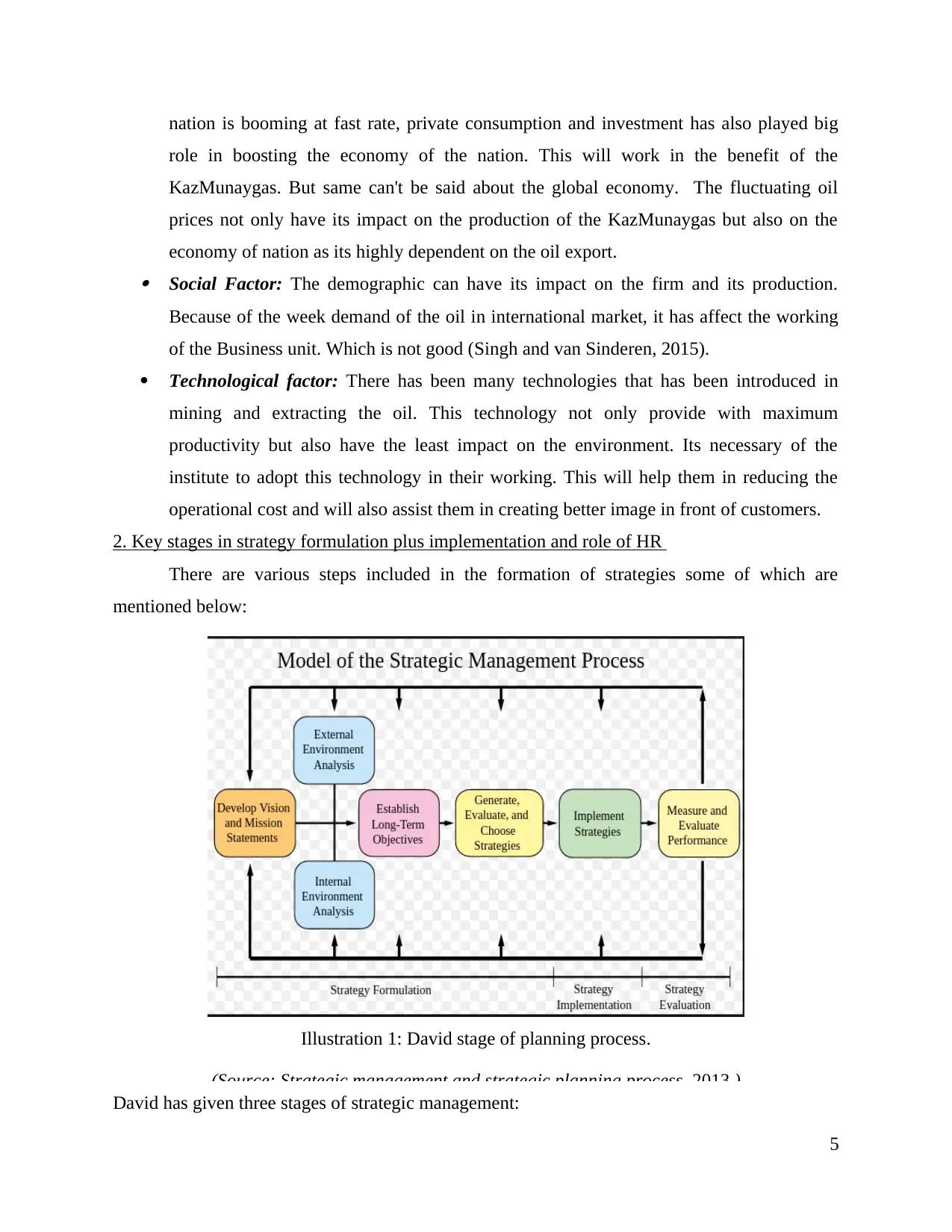
nation is booming at fast rate, private consumption and investment has also played big
role in boosting the economy of the nation. This will work in the benefit of the
KazMunaygas. But same can't be said about the global economy. The fluctuating oil
prices not only have its impact on the production of the KazMunaygas but also on the
economy of nation as its highly dependent on the oil export. Social Factor: The demographic can have its impact on the firm and its production.
Because of the week demand of the oil in international market, it has affect the working
of the Business unit. Which is not good (Singh and van Sinderen, 2015).
Technological factor: There has been many technologies that has been introduced in
mining and extracting the oil. This technology not only provide with maximum
productivity but also have the least impact on the environment. Its necessary of the
institute to adopt this technology in their working. This will help them in reducing the
operational cost and will also assist them in creating better image in front of customers.
2. Key stages in strategy formulation plus implementation and role of HR
There are various steps included in the formation of strategies some of which are
mentioned below:
Illustration 1: David stage of planning process.
(Source: Strategic management and strategic planning process. 2013.)
David has given three stages of strategic management:
5
role in boosting the economy of the nation. This will work in the benefit of the
KazMunaygas. But same can't be said about the global economy. The fluctuating oil
prices not only have its impact on the production of the KazMunaygas but also on the
economy of nation as its highly dependent on the oil export. Social Factor: The demographic can have its impact on the firm and its production.
Because of the week demand of the oil in international market, it has affect the working
of the Business unit. Which is not good (Singh and van Sinderen, 2015).
Technological factor: There has been many technologies that has been introduced in
mining and extracting the oil. This technology not only provide with maximum
productivity but also have the least impact on the environment. Its necessary of the
institute to adopt this technology in their working. This will help them in reducing the
operational cost and will also assist them in creating better image in front of customers.
2. Key stages in strategy formulation plus implementation and role of HR
There are various steps included in the formation of strategies some of which are
mentioned below:
Illustration 1: David stage of planning process.
(Source: Strategic management and strategic planning process. 2013.)
David has given three stages of strategic management:
5
Paraphrase This Document
Need a fresh take? Get an instant paraphrase of this document with our AI Paraphraser
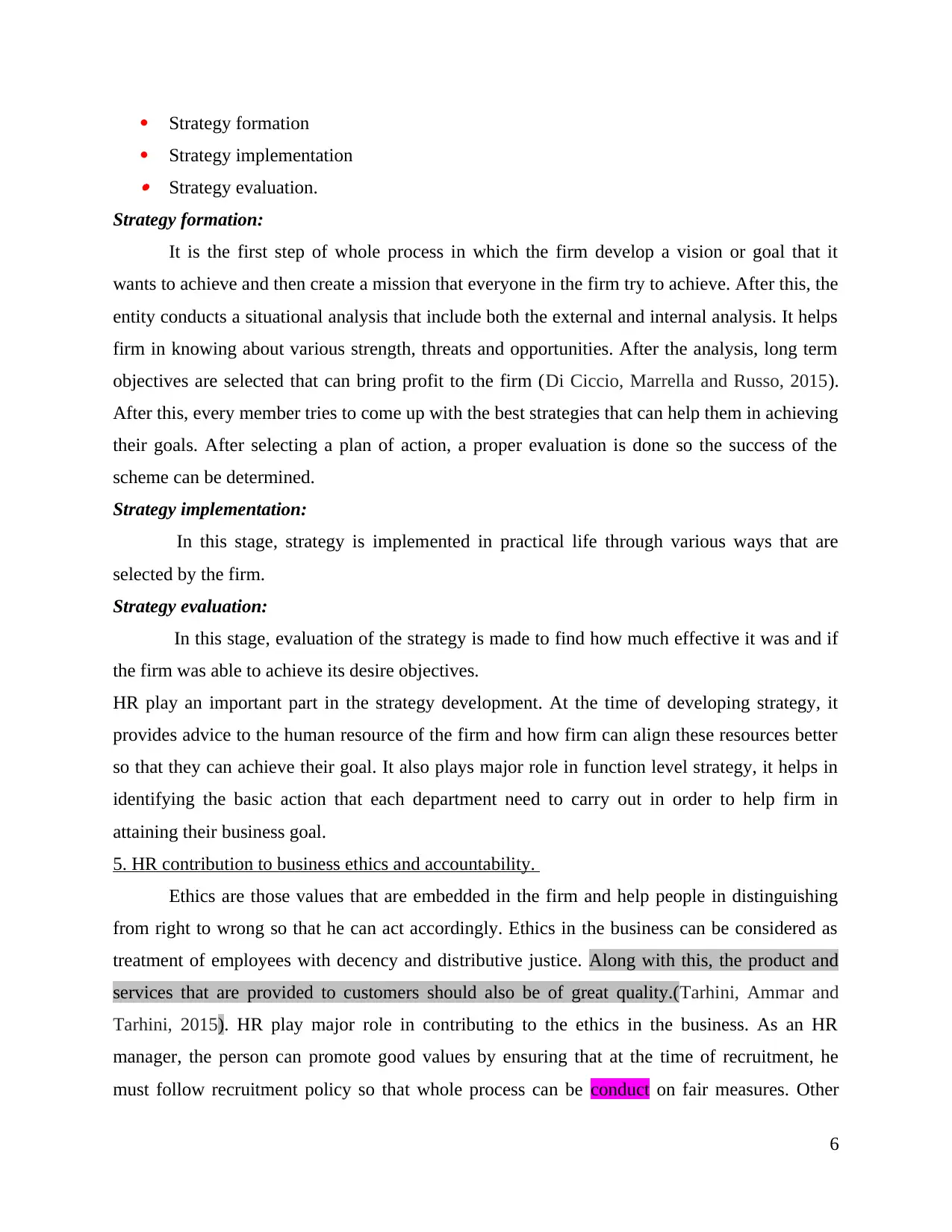
Strategy formation
Strategy implementation Strategy evaluation.
Strategy formation:
It is the first step of whole process in which the firm develop a vision or goal that it
wants to achieve and then create a mission that everyone in the firm try to achieve. After this, the
entity conducts a situational analysis that include both the external and internal analysis. It helps
firm in knowing about various strength, threats and opportunities. After the analysis, long term
objectives are selected that can bring profit to the firm (Di Ciccio, Marrella and Russo, 2015).
After this, every member tries to come up with the best strategies that can help them in achieving
their goals. After selecting a plan of action, a proper evaluation is done so the success of the
scheme can be determined.
Strategy implementation:
In this stage, strategy is implemented in practical life through various ways that are
selected by the firm.
Strategy evaluation:
In this stage, evaluation of the strategy is made to find how much effective it was and if
the firm was able to achieve its desire objectives.
HR play an important part in the strategy development. At the time of developing strategy, it
provides advice to the human resource of the firm and how firm can align these resources better
so that they can achieve their goal. It also plays major role in function level strategy, it helps in
identifying the basic action that each department need to carry out in order to help firm in
attaining their business goal.
5. HR contribution to business ethics and accountability.
Ethics are those values that are embedded in the firm and help people in distinguishing
from right to wrong so that he can act accordingly. Ethics in the business can be considered as
treatment of employees with decency and distributive justice. Along with this, the product and
services that are provided to customers should also be of great quality.(Tarhini, Ammar and
Tarhini, 2015). HR play major role in contributing to the ethics in the business. As an HR
manager, the person can promote good values by ensuring that at the time of recruitment, he
must follow recruitment policy so that whole process can be conduct on fair measures. Other
6
Strategy implementation Strategy evaluation.
Strategy formation:
It is the first step of whole process in which the firm develop a vision or goal that it
wants to achieve and then create a mission that everyone in the firm try to achieve. After this, the
entity conducts a situational analysis that include both the external and internal analysis. It helps
firm in knowing about various strength, threats and opportunities. After the analysis, long term
objectives are selected that can bring profit to the firm (Di Ciccio, Marrella and Russo, 2015).
After this, every member tries to come up with the best strategies that can help them in achieving
their goals. After selecting a plan of action, a proper evaluation is done so the success of the
scheme can be determined.
Strategy implementation:
In this stage, strategy is implemented in practical life through various ways that are
selected by the firm.
Strategy evaluation:
In this stage, evaluation of the strategy is made to find how much effective it was and if
the firm was able to achieve its desire objectives.
HR play an important part in the strategy development. At the time of developing strategy, it
provides advice to the human resource of the firm and how firm can align these resources better
so that they can achieve their goal. It also plays major role in function level strategy, it helps in
identifying the basic action that each department need to carry out in order to help firm in
attaining their business goal.
5. HR contribution to business ethics and accountability.
Ethics are those values that are embedded in the firm and help people in distinguishing
from right to wrong so that he can act accordingly. Ethics in the business can be considered as
treatment of employees with decency and distributive justice. Along with this, the product and
services that are provided to customers should also be of great quality.(Tarhini, Ammar and
Tarhini, 2015). HR play major role in contributing to the ethics in the business. As an HR
manager, the person can promote good values by ensuring that at the time of recruitment, he
must follow recruitment policy so that whole process can be conduct on fair measures. Other
6
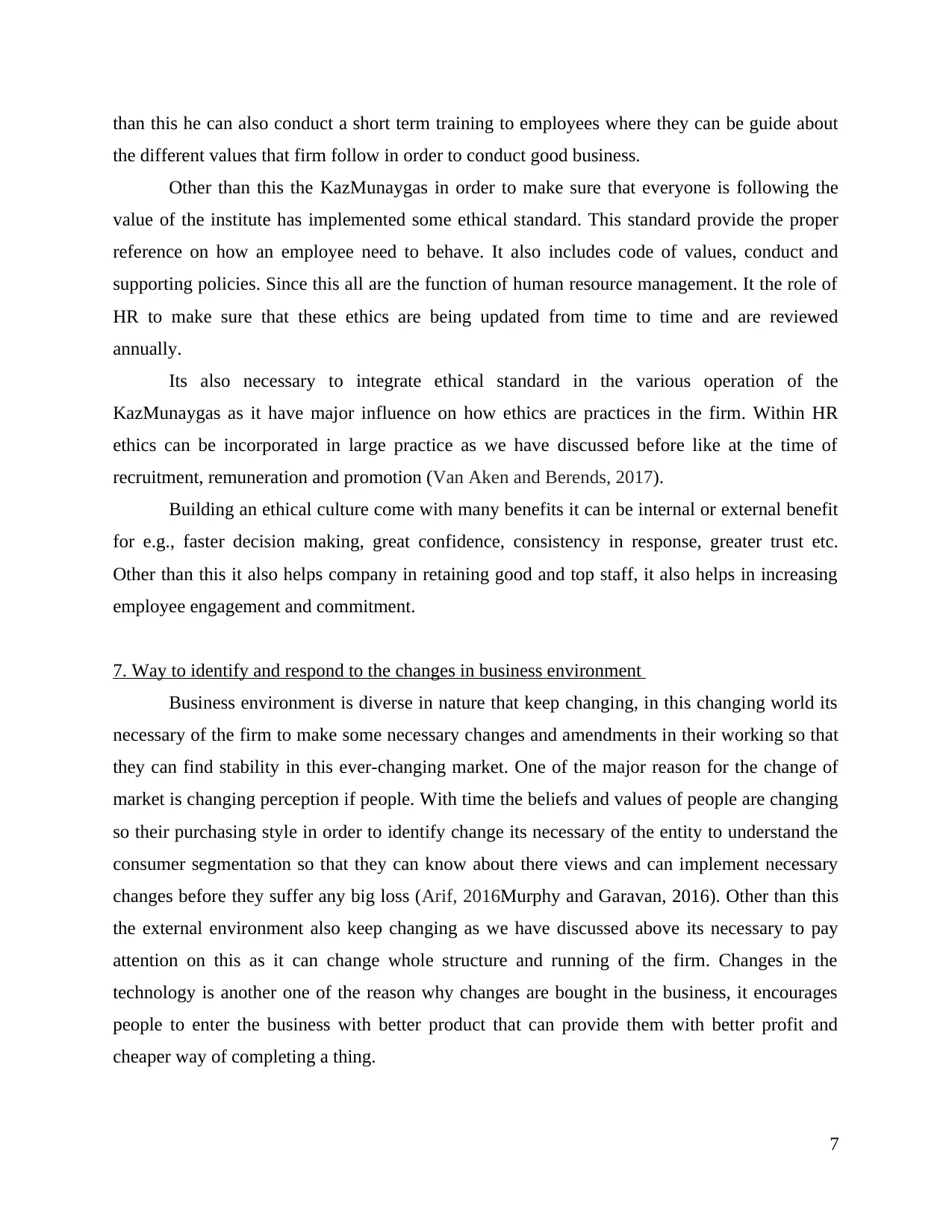
than this he can also conduct a short term training to employees where they can be guide about
the different values that firm follow in order to conduct good business.
Other than this the KazMunaygas in order to make sure that everyone is following the
value of the institute has implemented some ethical standard. This standard provide the proper
reference on how an employee need to behave. It also includes code of values, conduct and
supporting policies. Since this all are the function of human resource management. It the role of
HR to make sure that these ethics are being updated from time to time and are reviewed
annually.
Its also necessary to integrate ethical standard in the various operation of the
KazMunaygas as it have major influence on how ethics are practices in the firm. Within HR
ethics can be incorporated in large practice as we have discussed before like at the time of
recruitment, remuneration and promotion (Van Aken and Berends, 2017).
Building an ethical culture come with many benefits it can be internal or external benefit
for e.g., faster decision making, great confidence, consistency in response, greater trust etc.
Other than this it also helps company in retaining good and top staff, it also helps in increasing
employee engagement and commitment.
7. Way to identify and respond to the changes in business environment
Business environment is diverse in nature that keep changing, in this changing world its
necessary of the firm to make some necessary changes and amendments in their working so that
they can find stability in this ever-changing market. One of the major reason for the change of
market is changing perception if people. With time the beliefs and values of people are changing
so their purchasing style in order to identify change its necessary of the entity to understand the
consumer segmentation so that they can know about there views and can implement necessary
changes before they suffer any big loss (Arif, 2016Murphy and Garavan, 2016). Other than this
the external environment also keep changing as we have discussed above its necessary to pay
attention on this as it can change whole structure and running of the firm. Changes in the
technology is another one of the reason why changes are bought in the business, it encourages
people to enter the business with better product that can provide them with better profit and
cheaper way of completing a thing.
7
the different values that firm follow in order to conduct good business.
Other than this the KazMunaygas in order to make sure that everyone is following the
value of the institute has implemented some ethical standard. This standard provide the proper
reference on how an employee need to behave. It also includes code of values, conduct and
supporting policies. Since this all are the function of human resource management. It the role of
HR to make sure that these ethics are being updated from time to time and are reviewed
annually.
Its also necessary to integrate ethical standard in the various operation of the
KazMunaygas as it have major influence on how ethics are practices in the firm. Within HR
ethics can be incorporated in large practice as we have discussed before like at the time of
recruitment, remuneration and promotion (Van Aken and Berends, 2017).
Building an ethical culture come with many benefits it can be internal or external benefit
for e.g., faster decision making, great confidence, consistency in response, greater trust etc.
Other than this it also helps company in retaining good and top staff, it also helps in increasing
employee engagement and commitment.
7. Way to identify and respond to the changes in business environment
Business environment is diverse in nature that keep changing, in this changing world its
necessary of the firm to make some necessary changes and amendments in their working so that
they can find stability in this ever-changing market. One of the major reason for the change of
market is changing perception if people. With time the beliefs and values of people are changing
so their purchasing style in order to identify change its necessary of the entity to understand the
consumer segmentation so that they can know about there views and can implement necessary
changes before they suffer any big loss (Arif, 2016Murphy and Garavan, 2016). Other than this
the external environment also keep changing as we have discussed above its necessary to pay
attention on this as it can change whole structure and running of the firm. Changes in the
technology is another one of the reason why changes are bought in the business, it encourages
people to enter the business with better product that can provide them with better profit and
cheaper way of completing a thing.
7
⊘ This is a preview!⊘
Do you want full access?
Subscribe today to unlock all pages.

Trusted by 1+ million students worldwide
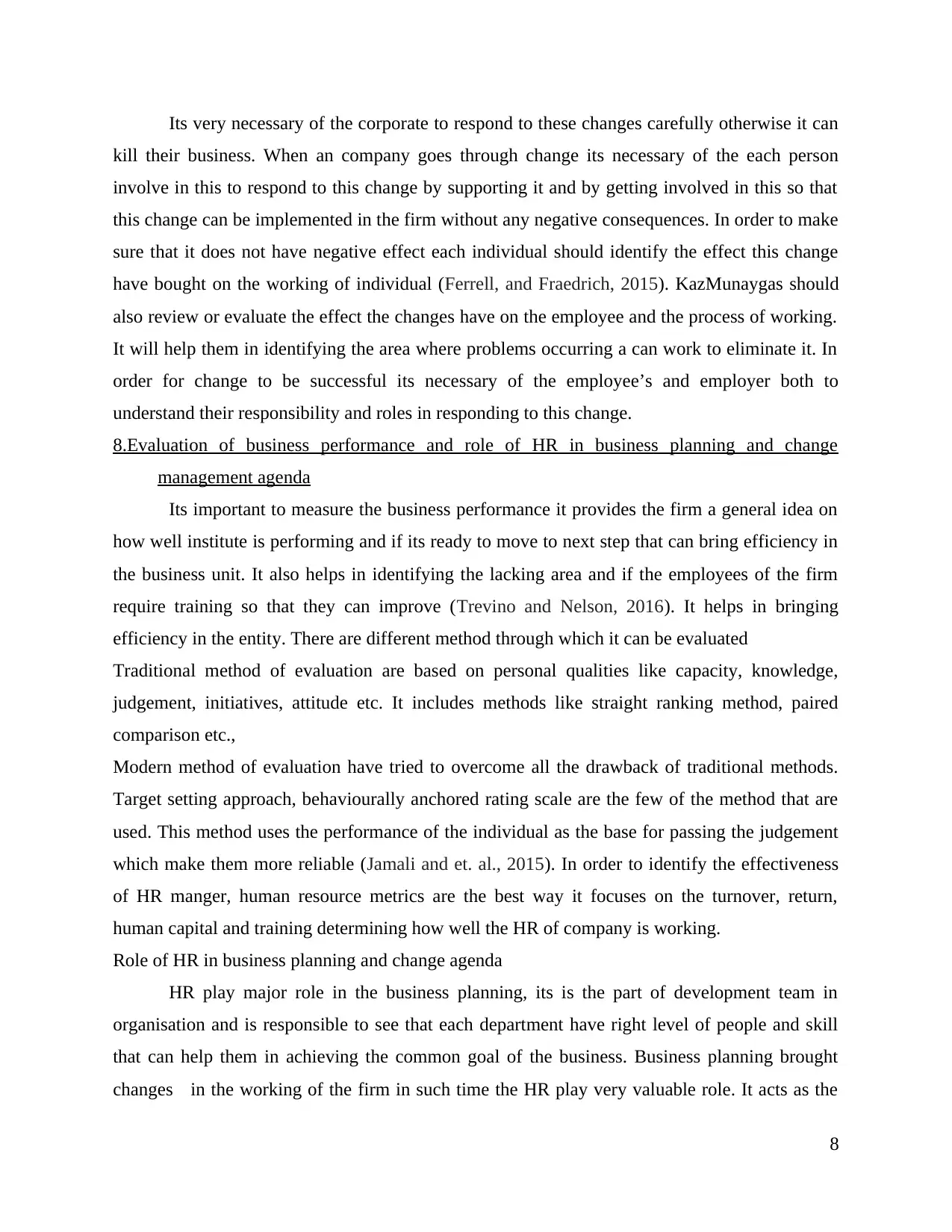
Its very necessary of the corporate to respond to these changes carefully otherwise it can
kill their business. When an company goes through change its necessary of the each person
involve in this to respond to this change by supporting it and by getting involved in this so that
this change can be implemented in the firm without any negative consequences. In order to make
sure that it does not have negative effect each individual should identify the effect this change
have bought on the working of individual (Ferrell, and Fraedrich, 2015). KazMunaygas should
also review or evaluate the effect the changes have on the employee and the process of working.
It will help them in identifying the area where problems occurring a can work to eliminate it. In
order for change to be successful its necessary of the employee’s and employer both to
understand their responsibility and roles in responding to this change.
8.Evaluation of business performance and role of HR in business planning and change
management agenda
Its important to measure the business performance it provides the firm a general idea on
how well institute is performing and if its ready to move to next step that can bring efficiency in
the business unit. It also helps in identifying the lacking area and if the employees of the firm
require training so that they can improve (Trevino and Nelson, 2016). It helps in bringing
efficiency in the entity. There are different method through which it can be evaluated
Traditional method of evaluation are based on personal qualities like capacity, knowledge,
judgement, initiatives, attitude etc. It includes methods like straight ranking method, paired
comparison etc.,
Modern method of evaluation have tried to overcome all the drawback of traditional methods.
Target setting approach, behaviourally anchored rating scale are the few of the method that are
used. This method uses the performance of the individual as the base for passing the judgement
which make them more reliable (Jamali and et. al., 2015). In order to identify the effectiveness
of HR manger, human resource metrics are the best way it focuses on the turnover, return,
human capital and training determining how well the HR of company is working.
Role of HR in business planning and change agenda
HR play major role in the business planning, its is the part of development team in
organisation and is responsible to see that each department have right level of people and skill
that can help them in achieving the common goal of the business. Business planning brought
changes in the working of the firm in such time the HR play very valuable role. It acts as the
8
kill their business. When an company goes through change its necessary of the each person
involve in this to respond to this change by supporting it and by getting involved in this so that
this change can be implemented in the firm without any negative consequences. In order to make
sure that it does not have negative effect each individual should identify the effect this change
have bought on the working of individual (Ferrell, and Fraedrich, 2015). KazMunaygas should
also review or evaluate the effect the changes have on the employee and the process of working.
It will help them in identifying the area where problems occurring a can work to eliminate it. In
order for change to be successful its necessary of the employee’s and employer both to
understand their responsibility and roles in responding to this change.
8.Evaluation of business performance and role of HR in business planning and change
management agenda
Its important to measure the business performance it provides the firm a general idea on
how well institute is performing and if its ready to move to next step that can bring efficiency in
the business unit. It also helps in identifying the lacking area and if the employees of the firm
require training so that they can improve (Trevino and Nelson, 2016). It helps in bringing
efficiency in the entity. There are different method through which it can be evaluated
Traditional method of evaluation are based on personal qualities like capacity, knowledge,
judgement, initiatives, attitude etc. It includes methods like straight ranking method, paired
comparison etc.,
Modern method of evaluation have tried to overcome all the drawback of traditional methods.
Target setting approach, behaviourally anchored rating scale are the few of the method that are
used. This method uses the performance of the individual as the base for passing the judgement
which make them more reliable (Jamali and et. al., 2015). In order to identify the effectiveness
of HR manger, human resource metrics are the best way it focuses on the turnover, return,
human capital and training determining how well the HR of company is working.
Role of HR in business planning and change agenda
HR play major role in the business planning, its is the part of development team in
organisation and is responsible to see that each department have right level of people and skill
that can help them in achieving the common goal of the business. Business planning brought
changes in the working of the firm in such time the HR play very valuable role. It acts as the
8
Paraphrase This Document
Need a fresh take? Get an instant paraphrase of this document with our AI Paraphraser
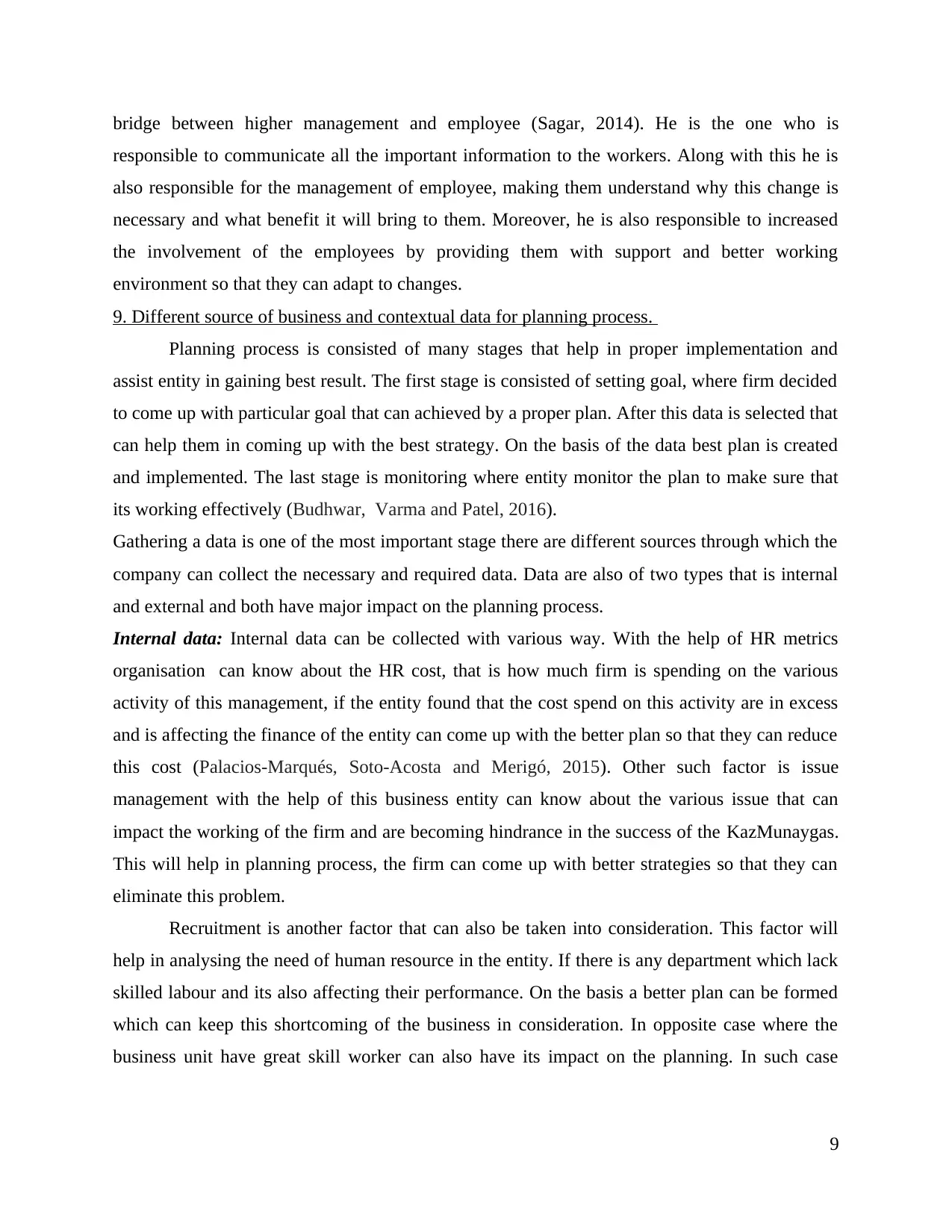
bridge between higher management and employee (Sagar, 2014). He is the one who is
responsible to communicate all the important information to the workers. Along with this he is
also responsible for the management of employee, making them understand why this change is
necessary and what benefit it will bring to them. Moreover, he is also responsible to increased
the involvement of the employees by providing them with support and better working
environment so that they can adapt to changes.
9. Different source of business and contextual data for planning process.
Planning process is consisted of many stages that help in proper implementation and
assist entity in gaining best result. The first stage is consisted of setting goal, where firm decided
to come up with particular goal that can achieved by a proper plan. After this data is selected that
can help them in coming up with the best strategy. On the basis of the data best plan is created
and implemented. The last stage is monitoring where entity monitor the plan to make sure that
its working effectively (Budhwar, Varma and Patel, 2016).
Gathering a data is one of the most important stage there are different sources through which the
company can collect the necessary and required data. Data are also of two types that is internal
and external and both have major impact on the planning process.
Internal data: Internal data can be collected with various way. With the help of HR metrics
organisation can know about the HR cost, that is how much firm is spending on the various
activity of this management, if the entity found that the cost spend on this activity are in excess
and is affecting the finance of the entity can come up with the better plan so that they can reduce
this cost (Palacios-Marqués, Soto-Acosta and Merigó, 2015). Other such factor is issue
management with the help of this business entity can know about the various issue that can
impact the working of the firm and are becoming hindrance in the success of the KazMunaygas.
This will help in planning process, the firm can come up with better strategies so that they can
eliminate this problem.
Recruitment is another factor that can also be taken into consideration. This factor will
help in analysing the need of human resource in the entity. If there is any department which lack
skilled labour and its also affecting their performance. On the basis a better plan can be formed
which can keep this shortcoming of the business in consideration. In opposite case where the
business unit have great skill worker can also have its impact on the planning. In such case
9
responsible to communicate all the important information to the workers. Along with this he is
also responsible for the management of employee, making them understand why this change is
necessary and what benefit it will bring to them. Moreover, he is also responsible to increased
the involvement of the employees by providing them with support and better working
environment so that they can adapt to changes.
9. Different source of business and contextual data for planning process.
Planning process is consisted of many stages that help in proper implementation and
assist entity in gaining best result. The first stage is consisted of setting goal, where firm decided
to come up with particular goal that can achieved by a proper plan. After this data is selected that
can help them in coming up with the best strategy. On the basis of the data best plan is created
and implemented. The last stage is monitoring where entity monitor the plan to make sure that
its working effectively (Budhwar, Varma and Patel, 2016).
Gathering a data is one of the most important stage there are different sources through which the
company can collect the necessary and required data. Data are also of two types that is internal
and external and both have major impact on the planning process.
Internal data: Internal data can be collected with various way. With the help of HR metrics
organisation can know about the HR cost, that is how much firm is spending on the various
activity of this management, if the entity found that the cost spend on this activity are in excess
and is affecting the finance of the entity can come up with the better plan so that they can reduce
this cost (Palacios-Marqués, Soto-Acosta and Merigó, 2015). Other such factor is issue
management with the help of this business entity can know about the various issue that can
impact the working of the firm and are becoming hindrance in the success of the KazMunaygas.
This will help in planning process, the firm can come up with better strategies so that they can
eliminate this problem.
Recruitment is another factor that can also be taken into consideration. This factor will
help in analysing the need of human resource in the entity. If there is any department which lack
skilled labour and its also affecting their performance. On the basis a better plan can be formed
which can keep this shortcoming of the business in consideration. In opposite case where the
business unit have great skill worker can also have its impact on the planning. In such case
9
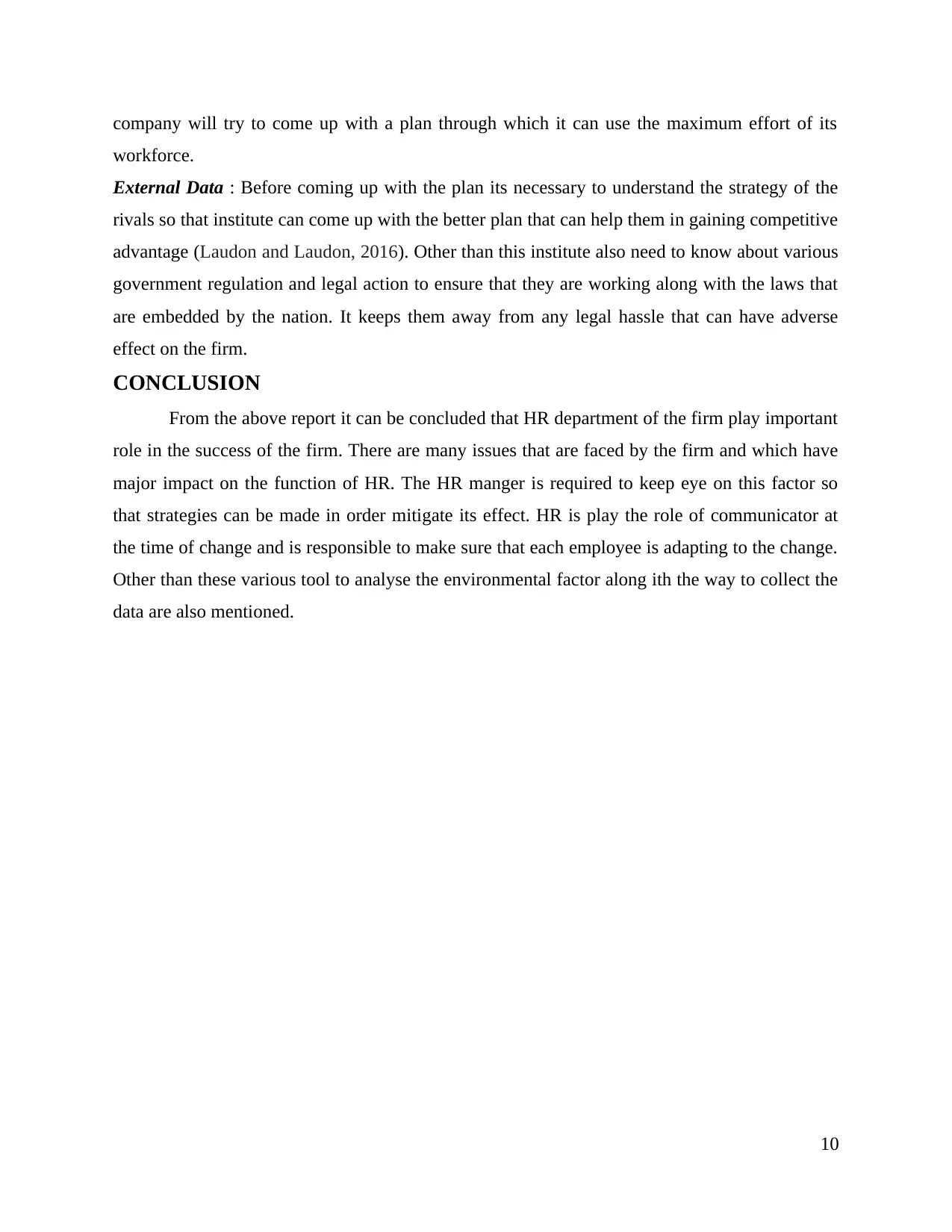
company will try to come up with a plan through which it can use the maximum effort of its
workforce.
External Data : Before coming up with the plan its necessary to understand the strategy of the
rivals so that institute can come up with the better plan that can help them in gaining competitive
advantage (Laudon and Laudon, 2016). Other than this institute also need to know about various
government regulation and legal action to ensure that they are working along with the laws that
are embedded by the nation. It keeps them away from any legal hassle that can have adverse
effect on the firm.
CONCLUSION
From the above report it can be concluded that HR department of the firm play important
role in the success of the firm. There are many issues that are faced by the firm and which have
major impact on the function of HR. The HR manger is required to keep eye on this factor so
that strategies can be made in order mitigate its effect. HR is play the role of communicator at
the time of change and is responsible to make sure that each employee is adapting to the change.
Other than these various tool to analyse the environmental factor along ith the way to collect the
data are also mentioned.
10
workforce.
External Data : Before coming up with the plan its necessary to understand the strategy of the
rivals so that institute can come up with the better plan that can help them in gaining competitive
advantage (Laudon and Laudon, 2016). Other than this institute also need to know about various
government regulation and legal action to ensure that they are working along with the laws that
are embedded by the nation. It keeps them away from any legal hassle that can have adverse
effect on the firm.
CONCLUSION
From the above report it can be concluded that HR department of the firm play important
role in the success of the firm. There are many issues that are faced by the firm and which have
major impact on the function of HR. The HR manger is required to keep eye on this factor so
that strategies can be made in order mitigate its effect. HR is play the role of communicator at
the time of change and is responsible to make sure that each employee is adapting to the change.
Other than these various tool to analyse the environmental factor along ith the way to collect the
data are also mentioned.
10
⊘ This is a preview!⊘
Do you want full access?
Subscribe today to unlock all pages.

Trusted by 1+ million students worldwide
1 out of 14
Related Documents
Your All-in-One AI-Powered Toolkit for Academic Success.
+13062052269
info@desklib.com
Available 24*7 on WhatsApp / Email
![[object Object]](/_next/static/media/star-bottom.7253800d.svg)
Unlock your academic potential
Copyright © 2020–2025 A2Z Services. All Rights Reserved. Developed and managed by ZUCOL.





